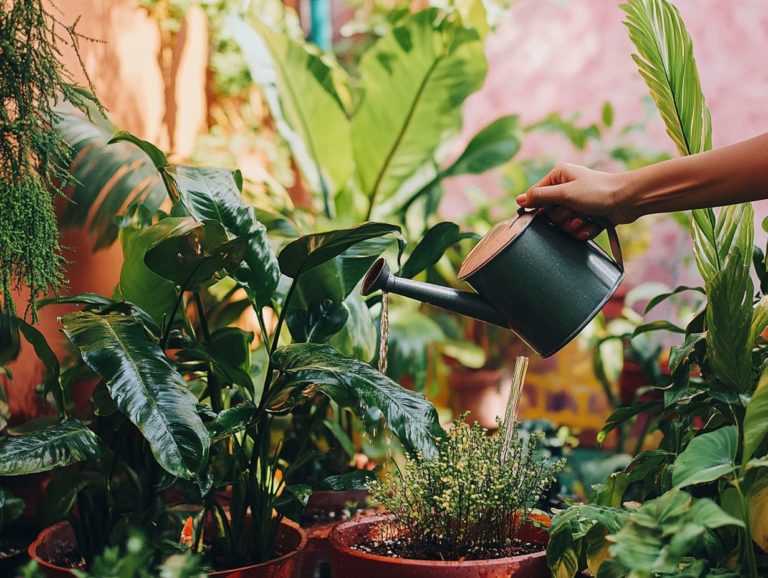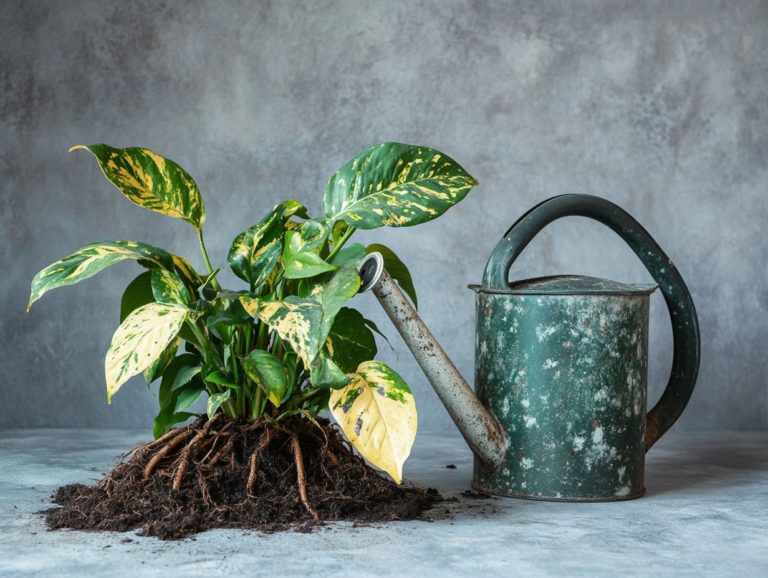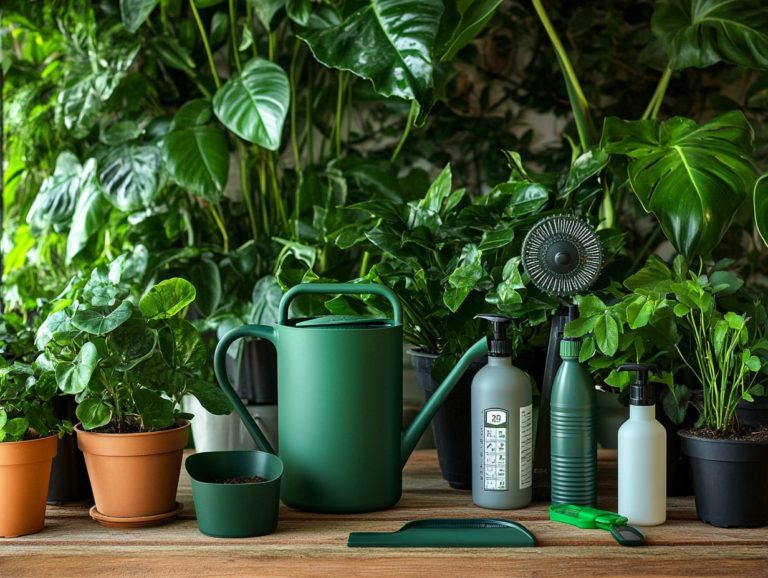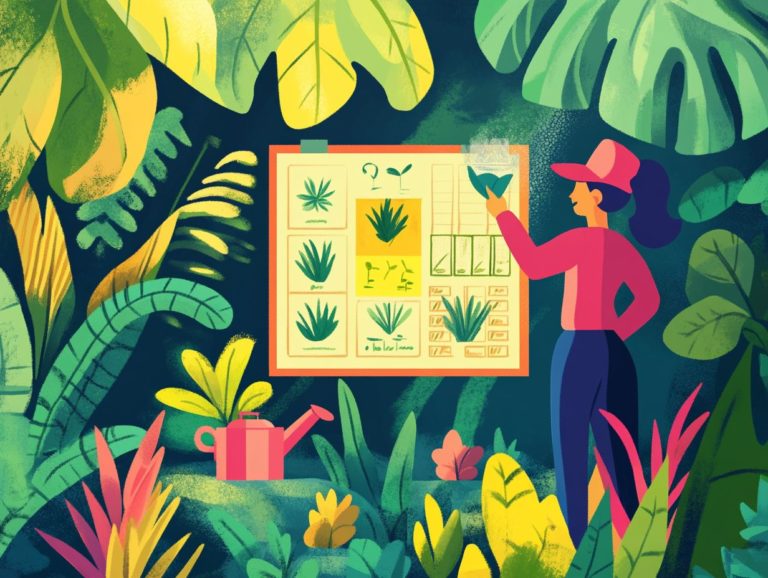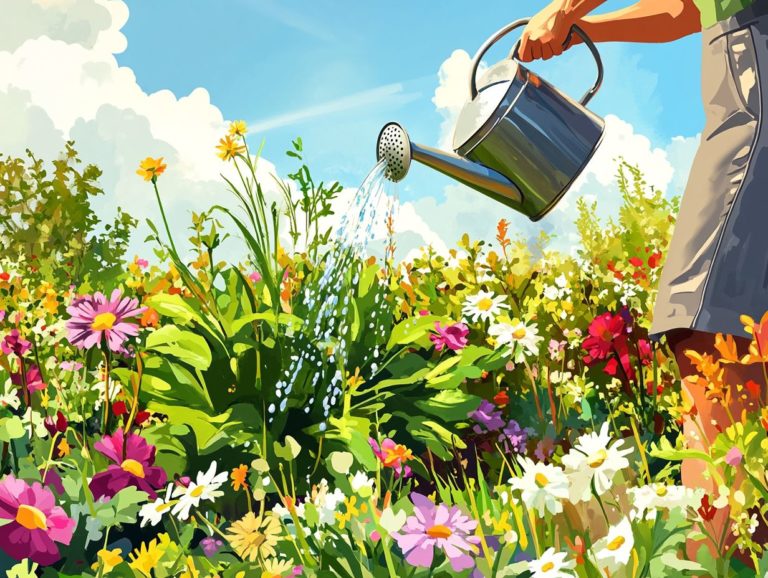The Best Watering Schedule for Common Plants
Understanding how to water plants is vital for their health and growth. This is true in various environments.
This guide explores the factors that affect watering needs. These include plant type and environmental conditions like light and humidity.
Learn to recognize signs of over or under watering. You’ll also discover tips to maintain proper moisture levels.
Find practical tools, such as apps and moisture meters, to enhance your watering routine. This will make it efficient and effective.
Contents
- Key Takeaways:
- Understanding Plant Watering Needs
- General Watering Guidelines
- Watering Schedule for Specific Types of Plants
- Indoor Plants
- Signs of Over and Under-watering
- Identifying and Addressing Watering Issues
- Additional Tips for Proper Plant Watering
- Using the Right Tools and Techniques
- Frequently Asked Questions
- What is the importance of having a watering schedule for common plants?
- How often should I water my common plants?
- How can I determine if my plants need watering?
- What is the best time of day to water common plants?
- What happens if I over-water my common plants?
- Can I use a watering schedule for all types of common plants?
Key Takeaways:
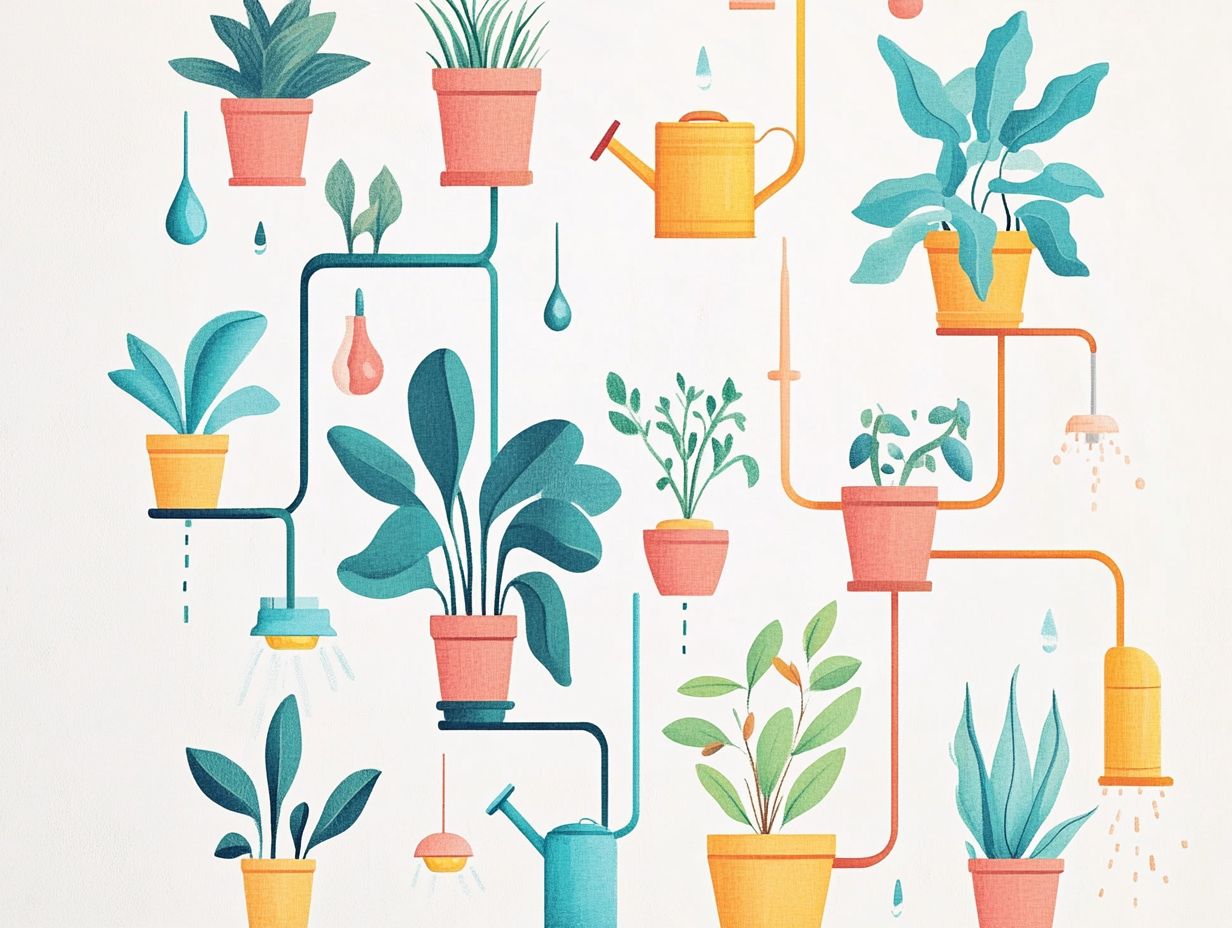
- Understand your plants’ watering needs by considering factors like soil type, climate, and plant type.
- Follow general guidelines for watering, such as watering deeply but less frequently, to ensure healthy plant growth.
- Create a specific watering schedule for your plants, taking into account their individual needs based on their type.
Understanding Plant Watering Needs
Understanding your plants’ watering needs is essential for fostering healthy growth and lush foliage. Each plant, whether it’s Alocasia Polly, Pothos, or Fiddle Leaf Fig, comes with its own unique requirements, shaped by factors like light, humidity, and soil conditions.
For example, tropical plants such as Peace Lily flourish in high humidity, while succulents like ZZ Plant and Dracaena marginata lean towards drier environments.
By maintaining a well-monitored watering schedule, you can prevent common pitfalls like overwatering or under watering. It’s vital for any indoor gardener to regularly assess their plants’ moisture needs to ensure they thrive.
Factors Affecting Watering Requirements
Several factors significantly influence the watering requirements of your plants, including climate, temperature, and soil conditions. By understanding how these elements interact, you can determine the optimal frequency and amount of water needed, ensuring your plants thrive in their environment.
Seasonal changes can cause temperature fluctuations that either increase or decrease moisture evaporation from the soil, making it essential for you to assess your watering habits carefully. High humidity levels can also affect the rate at which the soil dries out, which in turn impacts how often you need to water. Utilizing tools like moisture meters, which measure the water content in soil, can be invaluable for gauging hydration levels, allowing you to make adjustments based on real-time data.
The health of a plant’s root system is also crucial. Well-developed roots efficiently absorb water, reducing overall watering needs.
General Watering Guidelines
Establishing clear watering guidelines is crucial for your plants’ health. A structured schedule helps prevent root rot and wilting two problems you want to avoid!
Frequency and Amount of Watering
The frequency and amount of watering are crucial elements in your plant care routine, as different species have unique needs. For instance, succulents typically require less frequent watering than tropical plants. Understanding the right approach to watering can lead to healthier plants and more vibrant foliage.
To accurately assess when to water, consider factors such as soil type, which can vary from sandy, fast-draining mixtures to heavy clay that retains moisture. You can use moisture tracking methods, like the finger test or moisture meters, to determine the optimal time to water. For more detailed insights, check out our guide on watering frequency for indoor plants. Keep an eye out for signals like yellowing leaves or wilting; these can indicate whether your plant is thirsty or receiving too much moisture.
By customizing the watering frequency and quantity to suit the specific needs of each plant type and their growing conditions, you can cultivate a flourishing garden that brings life and beauty to your space.
Watering Schedule for Specific Types of Plants

A meticulously crafted watering schedule, tailored to the unique needs of each plant type, is crucial for achieving optimal growth. Consider indoor plants such as Dracaena Lisa and Marimo moss balls; their requirements differ significantly from those of outdoor annuals and perennials.
By grasping the distinct needs of each category, you can provide the precise care necessary to promote their vitality and flourishing health.
Annuals and Perennials
Annuals and perennials showcase unique watering requirements shaped by their growth cycles and the environmental conditions they face. As you nurture annual plants, you’ll find they thrive in well-draining soil and often demand more frequent watering during their growing season.
In contrast, once established, perennials are generally more tolerant of drier conditions. For instance, popular annuals like petunias and marigolds thrive in rich, moist settings, requiring consistent moisture to keep their vibrant blooms alive throughout their short life cycle.
Conversely, perennials such as lavender and coneflower boast root systems designed to withstand less frequent watering once their roots are securely anchored in the soil. The local climate is a significant factor; in arid regions, planning your watering schedules for annuals, complemented by effective mulching techniques, can yield impressive growth.
Meanwhile, perennials in similar settings may adapt over time, needing less water as they establish themselves.
Trees and Shrubs
Trees and shrubs, with their established resilience, come with distinct watering requirements that set them apart from smaller plants. They thrive on deeper watering to foster robust root systems. Maintaining proper moisture levels and ensuring adequate drainage are essential to keeping these larger plants healthy.
When evaluating the watering needs of these larger plants, consider their extensive root systems, which can delve deep into the soil, tapping into moisture reserves from lower levels. A solid guideline is to water deeply but less frequently, typically once a week during dry spells, ensuring that moisture penetrates at least 12 inches into the soil. For more insights, explore the best watering techniques for indoor plants.
It s important to be vigilant about drainage issues, as standing water can invite root rot and other unwelcome diseases. Adding mulch around the base not only helps retain moisture but also discourages weeds, further supporting the plant’s hydration needs.
Regularly monitoring soil moisture with a simple probe can yield valuable insights into when it s time for the next watering session.
Is your plant showing signs of thirst? Start a watering schedule today to keep your plants healthy and thriving!
Indoor Plants
Indoor plants, like Ferns and Calathea, need a thoughtful approach to their watering needs to flourish in your home. Factors such as light availability and humidity levels significantly influence how often and how much you should water them.
Take ferns, for example. They thrive in consistently moist soil but can fall victim to root rot if left in standing water. A savvy tactic is to check the top inch of the soil; if it s dry to the touch, it s time for a gentle watering.
Calatheas, on the other hand, revel in high humidity. You ll often find they require more frequent misting or a pebble tray filled with water to boost moisture in the air around them.
In bright, indirect light, both plants can dry out more quickly. Keeping an eye on their leaves for signs of stress will help you refine your watering strategy. Adjust your care routines based on seasonal changes, and refer to our guide on when to water houseplants to boost their growth and health.
Signs of Over and Under-watering
Knowing when your plants are thirsty or overwatered is key to keeping them healthy. For instance, droopy leaves may signal that your plant is thirsty, while yellowing leaves could indicate it s had too much water. Spot these signs quickly to take action and keep your plants thriving!
Identifying and Addressing Watering Issues

Identifying and addressing watering issues is crucial for maintaining plant health. Recognizing specific signs can guide you in fine-tuning your care routine. For instance, if you notice curling leaves, it might be a sign your plants are underwatered, while mushy roots could indicate overwatering.
Carefully watching your plants allows for early intervention, ensuring they thrive. Yellowing leaves can point to excessive moisture or nutrient deficiencies both of which can hinder growth. If the soil appears cracked or dry, it s a clear signal that it s time for a drink. Conversely, if water is pooling on the surface, you might be facing drainage issues. Stunted growth can hint at either scenario, so keeping a close eye on these signs will enable you to make timely adjustments.
Implementing solutions such as adjusting your watering frequency, enhancing soil aeration, or using well-draining pots can significantly elevate the vitality of your plants.
Additional Tips for Proper Plant Watering
Plus, grasping the nuances of watering schedules and employing the right tools and techniques can elevate your plant care routine to a new level. Try these tips today and watch your plants flourish!
For example, a watering can with a narrow spout allows for precise watering, ensuring each plant receives just what it needs. Meanwhile, a moisture meter offers accurate readings of soil moisture, helping you maintain ideal conditions for your plants.
These thoughtful strategies will keep your greenery thriving beautifully.
Using the Right Tools and Techniques
Employing the right tools and techniques for watering can significantly elevate the health and growth of your plants. Utilizing a moisture meter allows you to accurately gauge soil conditions, while a watering can with a long spout enables targeted hydration directly to the roots.
This thoughtful approach ensures that each plant receives just the right amount of moisture, mitigating the risk of over or under-watering, which can compromise delicate roots. A moisture meter eliminates guesswork, providing precise data on when to water, leading to healthier and more resilient greenery. For more insights, explore the science of watering indoor plants.
By combining these tools with proper watering techniques, such as using drip irrigation or soaker hoses, you can further enhance the effectiveness of your watering routine. Together, these practices conserve water and cultivate a thriving environment where your plants can flourish, illustrating the crucial connection between diligent care and effective tools.
This video offers valuable tips on how to keep your indoor plants healthy and vibrant.
Frequently Asked Questions
What is the importance of having a watering schedule for common plants?
A consistent watering schedule ensures that plants receive the right amount of water. This prevents under or over-watering, which can damage or even kill your plants.
How often should I water my common plants?
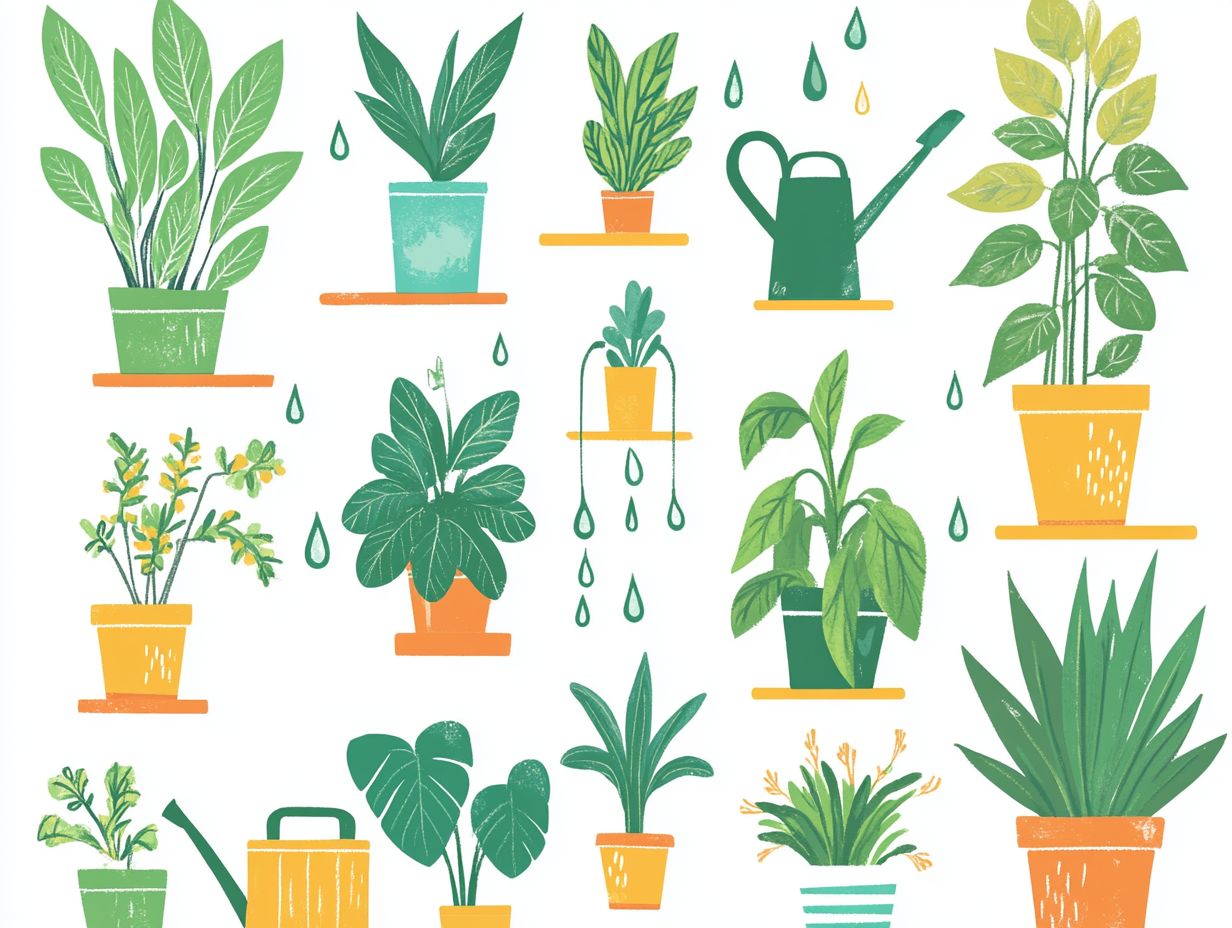
The frequency of watering varies based on plant type, weather, and soil moisture. Research the specific needs of your plants to create an effective watering schedule.
How can I determine if my plants need watering?
The best way to check if your plants need water is to test the soil moisture. Stick your finger about an inch into the soil; if it feels dry, it’s time to water.
You can also use a moisture meter, a tool that helps you measure how wet or dry the soil is.
What is the best time of day to water common plants?
The ideal time to water plants is in the early morning. This allows the water to soak in before the heat of the day evaporates it.
Watering in the evening can promote fungal diseases, so it’s best to avoid it.
What happens if I over-water my common plants?
Over-watering can lead to root rot, which may kill your plants. Common signs include wilting, yellowing leaves, and mushy roots.
If you suspect over-watering, reduce how often you water and check the soil moisture regularly.
Can I use a watering schedule for all types of common plants?
Absolutely not! Each plant has its own unique watering needs.
For example, cacti need less frequent watering, while tropical plants require more. Research each plant’s needs to create a tailored watering schedule.


